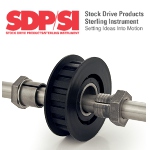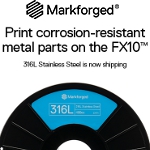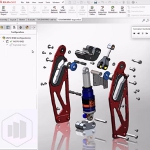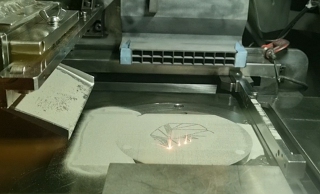 |
| November 14, 2023 | Volume 19 Issue 43 |
Mechanical News & Products
Designfax weekly eMagazine
Archives
Partners
Manufacturing Center
Product Spotlight
Modern Applications News
Metalworking Ideas For
Today's Job Shops
Tooling and Production
Strategies for large
metalworking plants
Superior fastening solution for securing rotating components to a shaft
 Shaftloc® fasteners offer distinct advantages over other fastening methods when securing rotating components to a shaft. The key to this compact, efficient design is its asymmetric thread geometry that produces a greater clamping force -- outperforming other fastening methods. Shaftloc is a patented fastening system manufactured by SDP/SI.
Shaftloc® fasteners offer distinct advantages over other fastening methods when securing rotating components to a shaft. The key to this compact, efficient design is its asymmetric thread geometry that produces a greater clamping force -- outperforming other fastening methods. Shaftloc is a patented fastening system manufactured by SDP/SI.
Learn more.
Print 316L stainless steel on Markforged printers
 316L Stainless Steel is now available for use with Markforged FX10 printers, allowing users to manufacture high-strength, accurate parts for demanding applications such as food and beverage processing, automotive, chemical and petrochemical processing, medical devices, and marine environments. This filament is safe and easy to handle. It makes machinable and polishable parts that have excellent corrosion resistance.
316L Stainless Steel is now available for use with Markforged FX10 printers, allowing users to manufacture high-strength, accurate parts for demanding applications such as food and beverage processing, automotive, chemical and petrochemical processing, medical devices, and marine environments. This filament is safe and easy to handle. It makes machinable and polishable parts that have excellent corrosion resistance.
Learn more.
10 best updates from the last 5 years: SOLIDWORKS
 Follow along with the experts at TriMech Group as they chronicle the top feature updates in SOLIDWORKS. Are you still using SOLIDWORKS 2020 -- or an even older version? Find out what you are missing, such as: enhanced rendering and new technical drawing tools; improved file sharing, collaboration, and workflows; advanced customization and UI improvements; faster and more efficient assemblies and simulations; and more.
Follow along with the experts at TriMech Group as they chronicle the top feature updates in SOLIDWORKS. Are you still using SOLIDWORKS 2020 -- or an even older version? Find out what you are missing, such as: enhanced rendering and new technical drawing tools; improved file sharing, collaboration, and workflows; advanced customization and UI improvements; faster and more efficient assemblies and simulations; and more.
View the TriMech video.
Engineer's Toolbox: How to design the optimum hinge
 Although many pin styles are available, Coiled Spring Pins are particularly well suited for
use in both friction- and free-fit hinges. To achieve optimum long-term hinge performance,
designers should observe these helpful design guidelines from SPIROL.
Although many pin styles are available, Coiled Spring Pins are particularly well suited for
use in both friction- and free-fit hinges. To achieve optimum long-term hinge performance,
designers should observe these helpful design guidelines from SPIROL.
Read the full article.
Innovative new robo welding gun
 Comau's newest N-WG welding gun is designed for high-speed spot welding for traditional, hybrid, and electric vehicles, in addition to general industry sectors. It features a patented, single-body architecture that enables rapid reconfiguration between welding types and forces, and it delivers consistent performance across a broad range of applications, including steel and (soon) aluminum welding. It supports both X and C standard gun configurations, has fast arm exchange, and universal mounting options. It is fully compatible with major robot brands and represents a significant advancement in spot welding performance and cost efficiency.
Comau's newest N-WG welding gun is designed for high-speed spot welding for traditional, hybrid, and electric vehicles, in addition to general industry sectors. It features a patented, single-body architecture that enables rapid reconfiguration between welding types and forces, and it delivers consistent performance across a broad range of applications, including steel and (soon) aluminum welding. It supports both X and C standard gun configurations, has fast arm exchange, and universal mounting options. It is fully compatible with major robot brands and represents a significant advancement in spot welding performance and cost efficiency.
Learn more.
What's a SLIC Pin®? Pin and cotter all in one!
 The SLIC Pin (Self-Locking Implanted Cotter Pin) from Pivot Point is a pin and cotter all in one. This one-piece locking clevis pin is cost saving, fast, and secure. It functions as a quick locking pin wherever you need a fast-lock function. It features a spring-loaded plunger that functions as an easy insertion ramp. This revolutionary fastening pin is very popular and used successfully in a wide range of applications.
The SLIC Pin (Self-Locking Implanted Cotter Pin) from Pivot Point is a pin and cotter all in one. This one-piece locking clevis pin is cost saving, fast, and secure. It functions as a quick locking pin wherever you need a fast-lock function. It features a spring-loaded plunger that functions as an easy insertion ramp. This revolutionary fastening pin is very popular and used successfully in a wide range of applications.
Learn more.
Engineering challenge: Which 3D-printed parts will fade?
 How does prolonged exposure to intense UV light impact 3D-printed plastics? Will they fade? This is what Xometry's Director of Application Engineering, Greg Paulsen, set to find out. In this video, Paulsen performs comprehensive tests on samples manufactured using various additive processes, including FDM, SLS, SLA, PolyJet, DLS, and LSPc, to determine their UV resistance. Very informative. Some results may surprise you.
How does prolonged exposure to intense UV light impact 3D-printed plastics? Will they fade? This is what Xometry's Director of Application Engineering, Greg Paulsen, set to find out. In this video, Paulsen performs comprehensive tests on samples manufactured using various additive processes, including FDM, SLS, SLA, PolyJet, DLS, and LSPc, to determine their UV resistance. Very informative. Some results may surprise you.
View the video.
Copper filament for 3D printing
 Virtual Foundry, the company that brought us 3D-printable lunar regolith simulant, says its popular Copper Filamet™ (not a typo) is "back in stock and ready for your next project." This material is compatible with any open-architecture FDM/FFF 3D printer. After sintering, final parts are 100% pure copper. Also available as pellets. The company says this is one of the easiest materials to print and sinter. New Porcelain Filamet™ available too.
Virtual Foundry, the company that brought us 3D-printable lunar regolith simulant, says its popular Copper Filamet™ (not a typo) is "back in stock and ready for your next project." This material is compatible with any open-architecture FDM/FFF 3D printer. After sintering, final parts are 100% pure copper. Also available as pellets. The company says this is one of the easiest materials to print and sinter. New Porcelain Filamet™ available too.
Learn more and get all the specs.
Copper foam -- so many advantages
 Copper foam from Goodfellow combines the outstanding thermal conductivity of copper with the structural benefits of a metal foam. These features are of particular interest to design engineers working in the fields of medical products and devices, defense systems and manned flight, power generation, and the manufacture of semiconductor devices. This product has a true skeletal structure with no voids, inclusions, or entrapments. A perennial favorite of Designfax readers.
Copper foam from Goodfellow combines the outstanding thermal conductivity of copper with the structural benefits of a metal foam. These features are of particular interest to design engineers working in the fields of medical products and devices, defense systems and manned flight, power generation, and the manufacture of semiconductor devices. This product has a true skeletal structure with no voids, inclusions, or entrapments. A perennial favorite of Designfax readers.
Learn more.
Full-color 3D-printing Design Guide from Xometry
 With Xometry's PolyJet 3D-printing service, you can order full-color 3D prints easily. Their no-cost design guide will help you learn about different aspects of 3D printing colorful parts, how to create and add color to your models, and best practices to keep in mind when printing in full color. Learn how to take full advantage of the 600,000 unique colors available in this flexible additive process.
With Xometry's PolyJet 3D-printing service, you can order full-color 3D prints easily. Their no-cost design guide will help you learn about different aspects of 3D printing colorful parts, how to create and add color to your models, and best practices to keep in mind when printing in full color. Learn how to take full advantage of the 600,000 unique colors available in this flexible additive process.
Get the Xometry guide.
Tech Tip: How to create high-quality STL files for 3D prints
 Have you ever 3D printed a part that had flat spots or faceted surfaces where smooth curves were supposed to be? You are not alone, and it's not your 3D printer's fault. According to Markforged, the culprit is likely a lack of resolution in the STL file used to create the part.
Have you ever 3D printed a part that had flat spots or faceted surfaces where smooth curves were supposed to be? You are not alone, and it's not your 3D printer's fault. According to Markforged, the culprit is likely a lack of resolution in the STL file used to create the part.
Read this detailed and informative Markforged blog.
Test your knowledge: High-temp adhesives
 Put your knowledge to the test by trying to answer these key questions on how to choose the right high-temperature-resistant adhesive. The technical experts from Master Bond cover critical information necessary for the selection process, including questions on glass transition temperature and service temperature range. Some of the answers may surprise even the savviest of engineers.
Put your knowledge to the test by trying to answer these key questions on how to choose the right high-temperature-resistant adhesive. The technical experts from Master Bond cover critical information necessary for the selection process, including questions on glass transition temperature and service temperature range. Some of the answers may surprise even the savviest of engineers.
Take the quiz.
Engineer's Toolbox: How to pin a shaft and hub assembly properly
 One of the primary benefits of using a coiled spring pin to affix a hub or gear to a shaft is the coiled pin's ability to prevent hole damage. Another is the coiled pin absorbs wider hole tolerances than any other press-fit pin. This translates to lower total manufacturing costs of the assembly. However, there are a few design guidelines that must be adhered to in order to achieve the maximum strength of the pinned system and prevent damage to the assembly.
One of the primary benefits of using a coiled spring pin to affix a hub or gear to a shaft is the coiled pin's ability to prevent hole damage. Another is the coiled pin absorbs wider hole tolerances than any other press-fit pin. This translates to lower total manufacturing costs of the assembly. However, there are a few design guidelines that must be adhered to in order to achieve the maximum strength of the pinned system and prevent damage to the assembly.
Read this very informative SPIROL article.
What's new in Creo Parametric 11.0?
 Creo Parametric 11.0 is packed with productivity-enhancing updates, and sometimes the smallest changes make the biggest impact in your daily workflows. Mark Potrzebowski, Technical Training Engineer, Rand 3D, runs through the newest functionality -- from improved surface modeling tools to smarter file management and model tree navigation. Videos provide extra instruction.
Creo Parametric 11.0 is packed with productivity-enhancing updates, and sometimes the smallest changes make the biggest impact in your daily workflows. Mark Potrzebowski, Technical Training Engineer, Rand 3D, runs through the newest functionality -- from improved surface modeling tools to smarter file management and model tree navigation. Videos provide extra instruction.
Read the full article.
What's so special about wave springs?
 Don't settle for ordinary springs. Opt for Rotor Clip wave springs. A wave spring is a type of flat wire compression spring characterized by its unique waveform-like structure. Unlike traditional coil springs, wave springs offer an innovative solution to complex engineering challenges, producing forces from bending, not torsion. Their standout feature lies in their ability to compress and expand efficiently while occupying up to 50% less axial space than traditional compression springs. Experience the difference Rotor Clip wave springs can make in your applications today!
Don't settle for ordinary springs. Opt for Rotor Clip wave springs. A wave spring is a type of flat wire compression spring characterized by its unique waveform-like structure. Unlike traditional coil springs, wave springs offer an innovative solution to complex engineering challenges, producing forces from bending, not torsion. Their standout feature lies in their ability to compress and expand efficiently while occupying up to 50% less axial space than traditional compression springs. Experience the difference Rotor Clip wave springs can make in your applications today!
View the video.
Lasers used to 'heat and beat' 3D-printed steel provide new benefits over traditional hardening techniques
Researchers have developed a new method for 3D printing metal that could help reduce costs and make more efficient use of resources.
The method, developed by a research team led by the University of Cambridge in the UK, allows structural modifications to be "programmed" into metal alloys during 3D printing, fine-tuning their properties without the "heating and beating" process that's been in use for thousands of years.
The new 3D-printing method combines the best qualities of both worlds: the complex shapes that 3D printing makes possible, and the ability to engineer the structure and properties of metals that traditional methods allow. The results are reported in the journal Nature Communications.
3D printing has several advantages over other manufacturing methods. For example, it's far easier to produce intricate shapes using 3D printing, and it uses far less material than traditional metal manufacturing methods, making it a more efficient process. However, it also has significant drawbacks.
"There's a lot of promise around 3D printing, but it's still not in wide use in industry, mostly because of high production costs," said Dr. Matteo Seita from Cambridge's Department of Engineering, who led the research. "One of the main drivers of these costs is the amount of tweaking that materials need after production."
Since the Bronze Age, metal parts have been made through a process of heating and beating. This approach, where the material is hardened with a hammer and softened by fire, allows the maker to form the metal into the desired shape and at the same time impart physical properties such as flexibility or strength.
"The reason why heating and beating is so effective is because it changes the internal structure of the material, allowing control over its properties," said Seita. "That's why it's still in use after thousands of years."
One of the major downsides of current 3D-printing techniques is an inability to control the internal structure in the same way, which is why so much post-production alteration is required. "We're trying to come up with ways to restore some of that structural engineering capability without the need for heating and beating, which would in turn help reduce costs," said Seita. "If you can control the properties you want in metals, you can leverage the greener aspects of 3D printing."
Working with colleagues in Singapore, Switzerland, Finland, and Australia, Seita developed a new recipe for 3D-printed metal that allows a high degree of control over the internal structure of the material as it is being melted by a laser.
By controlling the way the material solidifies after melting, and the amount of heat that is generated during the process, the researchers can program the properties of the end material. Normally, metals are designed to be strong and tough, so they are safe to use in structural applications. 3D-printed metals are inherently strong -- but also brittle.

This still shows laser powder bed fusion of a powder layer of stainless steel 316L in the custom-made machine "AddME Printer" at NTU in Singapore. [Credit: Jude E. Fronda]
The strategy the researchers developed gives full control over both strength and toughness by triggering a controlled reconfiguration of the microstructure when the 3D-printed metal part is placed in a furnace at relatively low temperature. Their method uses conventional laser-based 3D-printing technologies, but with a small tweak to the process.
"We found that the laser can be used as a 'microscopic hammer' to harden the metal during 3D printing," said Seita. "However, melting the metal a second time with the same laser relaxes the metal's structure, allowing the structural reconfiguration to take place when the part is placed in the furnace."
Their 3D-printed steel, which was designed theoretically and validated experimentally, was made with alternating regions of strong and tough material, making its performance comparable to steel that's been made through heating and beating.
"We think this method could help reduce the costs of metal 3D printing, which could in turn improve the sustainability of the metal manufacturing industry," said Seita. "In the near future, we also hope to be able to bypass the low-temperature treatment in the furnace, further reducing the number of steps required before using 3D-printed parts in engineering applications."
The team included researchers from Nanyang Technological University; the Agency for Science, Technology and Research (A*STAR); the Paul Scherrer Institute; VTT Technical Research Center of Finland; and the Australian Nuclear Science & Technology Organization. Matteo Seita is a Fellow of St John's College, Cambridge.
Source: University of Cambridge
Published November 2023
Rate this article
View our terms of use and privacy policy

